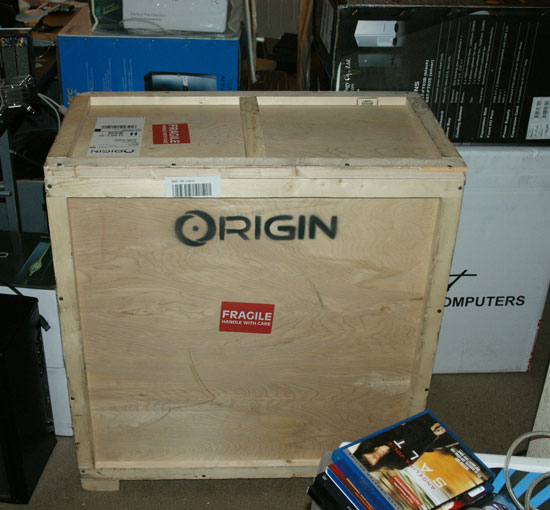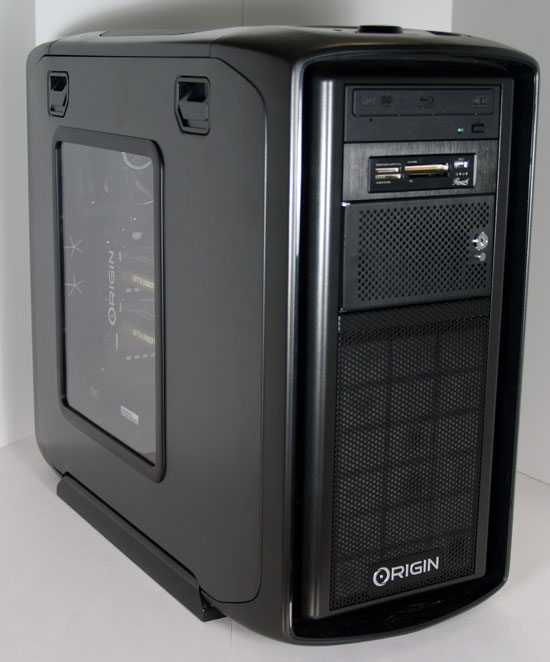Origin's Genesis: Flagship Bling
by Dustin Sklavos on April 2, 2011 2:00 PM ESTIntroducing the Origin Genesis
Now that we've been getting a fairly steady influx of desktop machines from boutiques, Origin PC is stepping into the ring by sending us their go-to flagship model, the Genesis. Origin is a boutique founded by former Alienware executives, and is relatively young compared to some of the other companies we've reviewed towers from. The Genesis is almost more of a brand than a flagship, but Origin is opting to put one of their best feet forward by sending us a configuration they're sure will do them proud against the competition.
After our pit stop with the iBuyPower LAN Warrior II, we're now back firmly in the realm of boutique desktop gaming towers. I should've known better when Kevin Wasielewski, the CEO, mentioned in his e-mail for me to contact him when the tower arrived with my thoughts on the packaging. Please try to ignore the mess, questionable taste in film, and mountain of additional hardware in the background needing my time and attention and get a load of this:

As I mentioned in the last review, I'm not a large man by any stretch of the imagination. So when the delivery man arrived in the morning and knocked on my door and asked me to help him bring a wooden crate up, I was understandably surprised. For scale, that's an Antec Mini P180 on the floor to the left of this 86 pound monstrosity. And what's inside?

As the proud owner of a Corsair Graphite 600T (the same case this Origin Genesis was built in), I can tell you that the packaging was decidedly American and absolute overkill, and I would've been more amused by it had I both the space and upper body strength to contend with it constructively.
| Origin Genesis Specifications | |
| Chassis | Corsair Graphite 600T with Side Window |
| Processor |
Intel Core i7-2600K @ 4.5GHz (45x100 BCLK) (spec: 4x3.4GHz, 32nm, 8MB L3, 95W) |
| Motherboard | ASUS P8P67 Pro Motherboard with P67 chipset |
| Memory | 2x4GB Kingston HyperX DDR3-1600 @ 1600MHz (expandable to 16GB) |
| Graphics |
2x EVGA NVIDIA GeForce GTX 560 Ti 1GB GDDR5 in SLI (384 CUDA Cores, 850MHz Core, 1701MHz Shaders, 4.1GHz RAM, 256-bit memory bus) |
| Hard Drive(s) |
Intel 510 128GB SATA 6Gbps SSD Western Digital Caviar Black 1TB 7200-RPM SATA 6Gbps HDD |
| Optical Drive(s) | Pioneer 12x BD-RE Drive |
| Networking |
Intel 82579V Gigabit Ethernet Bluetooth 2.1+EDR |
| Audio |
Realtek ALC892 HD Audio Speaker, mic, line-in, and surround jacks for 7.1 sound Digital and optical out |
| Front Side |
Optical drive Card reader with USB 2.0 |
| Top |
Headphone and mic jacks 4x USB 2.0 USB 3.0 6-pin FireWire Fan controller |
| Back Side |
2x PS/2 Optical and digital out 2x eSATA 6x USB 2.0 Bluetooth 6-pin FireWire 2x USB 3.0 Ethernet Speaker, mic, line-in, and surround jacks for 7.1 sound |
| Operating System | Windows 7 Home Premium 64-bit |
| Dimensions | 10.4" x 23.3" x 20" (WxDxH) |
| Weight | 28 lbs (case only) |
| Extras |
Silverstone 750W Power Supply 12-in-1 Card Reader Asetek 570LC Liquid Cooling SATA Hot-swap bay Internal LED lighting |
| Warranty | 1-year limited warranty and lifetime phone support |
| Pricing |
Starts at $1,337 Review system on website at $2,549 |
Now that Intel has begun shipping fixed P67/H67 chipsets in earnest, Sandy Bridge is all over the place in boutique builds, and Origin's Genesis is no different. It sports an Intel Core i7-2600K, the weapon of choice for pretty much everyone these days, with a healthy overclock of 4.5GHz. Origin advertises being able to push this chip over 5GHz and given what we know of i7-2600K overclocking that doesn't seem entirely unreasonable, though you'll pay for the privilege. They keep the processor cool with an Asetek 570LC 120mm watercooling kit.
The other major player in the Genesis is the pair of EVGA GeForce GTX 560 Ti cards running in SLI. These cards both feature a mild overclock to 850MHz on the core, 1.7GHz on the 384 shaders, and 4.1GHz on the GDDR5 attached to a 256-bit memory bus. A pair of 1GB GTX 460's in SLI was (and to an extent still is) a price/performance king, and the two 560's hopefully should build on that.
Origin's remaining component choices are solid and top shelf: a shiny new Intel 510 128GB SSD is used as a system drive while the boutique favorite Western Digital Caviar Black 1TB SATA 6Gbps hard disk handles storage duties. It's also nice to see a full 8GB of DDR3-1600 from a reputable brand, a blu-ray burner, and the SATA hotswap cage is a welcome nice touch.
Finally, everything is housed in Corsair's Graphite 600T, a case we've had the privilege of reviewing in the past, and powered by a respectable Silverstone 750-watt power supply. The 600T is no stranger to water cooling, but we'll see that not everything here is quite as good as it could be. Origin is also in a privileged position with Corsair and as a result are among the first to get their hands on the new windowed side panel which they make use of by illuminating the internals with strips of white LED lights.
What you'll want to notice are two components that aren't immediately available on the configuration page of Origin's site: the Corsair Graphite 600T and the SATA hot-swap bay. Origin will build systems by request in other enclosures, and the hot-swap bay becomes an option they can add alongside using the 600T.










39 Comments
View All Comments
brucek2 - Saturday, April 2, 2011 - link
Neither of those examples seems so bad to me? If PCMark is supposed to indicate overall PC responsiveness, then seeing a noticeable boost from a SSD seems correct? And we all know its possible for CPU to be the limiting factor in graphic performance depending on the game and graphic settings, especially at low resolutions like 1024x768?
tipoo - Saturday, April 2, 2011 - link
PCmark I somewhat agree with you, but 3D mark is supposed to represent the current gaming situation. Most games now are far more GPU bound than CPU bound, and 3DMark seems to represent that the opposite way.JarredWalton - Sunday, April 3, 2011 - link
The problem with PCMark is that while there are plenty of tasks where an SSD helps, there are also a lot of others where it doesn't do much. Gaming for me feels 99% the same with the game installed to a 1TB HDD vs. a fast SF-1200 SSD. (That's what my current gaming PC is using, incidentally.) Some things are dramatically faster, like installing Adobe Photoshop literally took 1/3 the time vs. an HDD, but while lots of stuff feels snappier there are too many things where an SSD doesn't help for a "system benchmark" to improve by nearly 100%. At least, that's my opinion on the matter.scook9 - Monday, April 4, 2011 - link
The problem is that they are using 3DMark benches that are OLDFor modern systems they should be using 3DMark Vantage at the default Performance settings (1280x1024) and 3DMark 11 at its default performance settings (1280x720) as these are the only settings that anyone will care about and compare to (also only "Official" results for ranking in both hwbot and ORB). Drop 03, 05 and even 06 as they are all notoriously CPU bound (as were the games nearly a decade ago....). Modern drivers also do not optimize for those older programs.
And something I found curious.....if they are so in bed with corsair.....why use a 570LC and not an H70?!
Solidstate89 - Saturday, April 2, 2011 - link
...a Silverstone Fortress FT03 box in the first image on page 1. That is certainly one of the more interesting cases I've seen come out of Silverstone.Rick83 - Saturday, April 2, 2011 - link
Yeah, currently planning my SB build in that (2600K, asus pro board, 2x4GB vengeance 1866 MHz RAM, a 6950 (oh but which?) a Yasya, and a 500W Enermax Modu 87+ (or maybe a seasonic X-FL?) as well as the obligatory slot-in sony optiarc...)Waiting until I can get it for less than a 1000 euros, or an insanely awesome Z68 board sweetens the deal...
Of course, the last review I read insinuated that the fans used in the case are low quality and will have to be replaced. And then there's the question which cooler layout for the graphics will be ideal....
Not quite a done deal yet.
tsekh - Saturday, April 2, 2011 - link
" Even with the Asetek liquid cooler running full bore (and oh how it runs full bore), you'll see temperatures are really quite high compared to other machines. At first it looked like my old nemesis, the Viscount von Lazyoverclocking, was rearing his ugly head, but a quick trip into UEFI revealed a fairly tuned overclock, complete with offset voltage. If anything it just looks like this particular chip needs a healthy amount of voltage pumped into it to hit high speeds;"No. That's definitely lazy overclocking. With Asus P8P67 Deluxe, my 2600k is running stable also at 4.5Ghz with offset voltage +0.03V, and the min/max CPU voltage I get using this setting is 0.984/1.288V. Most 2600k can do this speed at max voltage lower than 1.32V and a lot lower can do it at lower than 1.3V. Comapred to the max CPU voltage of 1.42V, one can expect at least 10C degree difference in load temperature, given a non-rubbish cooling system.
LtGoonRush - Saturday, April 2, 2011 - link
"given a non-rubbish cooling system." That right there is the problem, commercial water cooling products simply aren't even remotely competitive with air coolers. I've been harping on this for a long time, but it's true: water cooling is obsolete in the face of heatpipes, which provide better cooling, lower costs, lower noise, and higher reliability. This build uses the Asetek OEM version of the Corsair H70, for nearly $30 less a Thermalright Silver Arrow would have provided far better cooling with fans running at <1200rpm, and you don't have to worry about a pump potentially failing.The_Assimilator - Saturday, April 2, 2011 - link
@tsekhIf you know anything about overclocking then you'll know that not all CPUs are created equal. Just because you got a chips that clocks well doesn't mean Origin did. I've personally seen a 2600K that refuses to exceed 4.2GHz regardless of the volts/cooling applied.
@LtGoonRush
"commercial water cooling products simply aren't even remotely competitive with air coolers"
Wrong. I replaced a TRUE 120 with an H50 (using the same fans) and the H50 is cooler. Maybe if you're comparing commercial watercoolers to high-end aircoolers that statement is valid, but then the comparison isn't.
"a Thermalright Silver Arrow would have provided far better cooling with fans running at <1200rpm"
Except that the Silver Arrow is absolutely huge and monstrously heavy, which means that shipping it pre-installed is a bad idea, which makes it a non-option for a boutique PC that's going to be transported who knows how far.
tsekh - Saturday, April 2, 2011 - link
@ The_AssimilatorIf you know anything about overclocking then you should know there is a humongous difference 1.28V and 1.42V. If that particular 2600k can't OC to 4.5Ghz, it just can't and that's very rare. But if it can do 4.5Ghz, it definitely can do it at much lower voltage. 1.42V is simply a huge overkill. Also, you have to be either extremely unlucky, or simply a complete idiot, to fail to OC a 2600k past 4.2Ghz. Most people can do 4.2Ghz with everything on auto with their P67 motherboards. I hope it has to do with your bad luck.